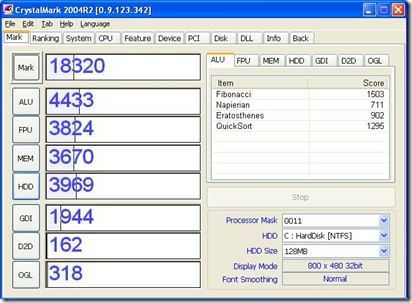The mouse pad is tiny and definitely a weak point if you’re planning to use the device in the traditional notebook manner but once you’re used to the touchscreen, the mouse pointer gets used less and less.
In general use the device is quite nice. The speed of the device, low noise levels, lack of screen reflection and good quality keyboard give a comfortable experience. I have no issues with using this device for writing blog entries, reading web pages, microblogging or uploading images. Its lower resolution helps, like the other things mentioned above, to make it an easy, comfortable experience from the word go.
As with other Menlow-powered devices, video is a hit and miss affair. The platform includes hardware assisted video decoding but with XP and flash videos, you’re never going to experience it. Tweaking some codecs and installing alternative video players can result in some impressive playback capability if you know what you’re doing but it’s a tweakers job. Skype performed quite well with a video-to-video call across Europe working extremely well. Boosting the standard mic setting was necessary but apart from that it was an good, if not high frame-rate experience. The built-in speakers and echo cancelation mean that no headset is necessary for a casual video call.

The CrystalMark test result shows a reasonable set of results for CPU, Memory and disk speed. As always with the Menlow platform, 2D and 3D results are quite poor.
Battery life is excellent on the TN70M. The four-cell, 37Wh battery returns 5 hours in normal use which is a great figure for a 900gm netbook-style device. Pair this with a 6-cell battery pack and you’ve got 15 hours battery life. Enough for two full days work without mains power.
Windows 7 testing.
Windows 7 installs and works well on the Clevo but I haven’t done extensive testing. One option for buying the Clevo would be to buy without an OS at Mobilx, install the RC1 version of Windows 7 (free until next February) and then decide what operating system to buy after that point.
Issues.
On the test device the auto rotate feature never worked properly. The driver appeared to crash at every start-up. After a long tinkering session I managed to kill the touchscreen drivers too! Apart from that though, the platform was nice and stable.
Further Notes
- The keyboard is good. Better than the Kojhinsha SC3 and SK3. Not as good as most netbooks. It only has 1 shift key.
- The fingerprint reader works and the software captures password too.
- The mouse pointer on the frame is a very good optical type which gives you great control in two-handed or tablet mode.
- Has strong Wi-Fi reception. (b/g modes)
- Appears to have about 5hrs battery life (although the battery indicator doesn’t show times)
- Has a soft touchscreen with a good level of palm rejection. The screen is matt but has a typical milky appearance in sunlight.
- Includes a rotation sensor (although the drive software appears to be broken on this model)
- Is as fast as any 1.3Ghz Menlow device for browsing. Sub 10-second average page load times.
- Includes a hard drive with a max throughput of 28MB/s
- Was silent for the whole 1hr testing session
- Has a removable back allowing RAM, HDD and PCI-express mini slot.
- Speakers are of acceptable quality.
Usage models
- Table top use as an occasional notebook
- Portable Skype video conferencing tool. The quality of the cam and audio are very good.
- Digital imaging preview and modification. (The CPU isn’t powerful enough for fast efficient viewing and editing of RAW images.)
- High-efficiency computing. This is a very efficient build.
- RV/ Caravan computer
- Backup-computer
Competition
Unfortunately for Clevo, every one of those usage models could be satisfied by buying a netbook. If you can find them, there are Eee PC 900’s and Aspire One 150’s with 1024×600 screens available for well under 300 Euros inclusive operating system and taxes. Granted, they aren’t as efficient as the Clevo but for general use, they will be better options.











New article: Clevo TN70M Netbook/UMPC Review. http://cli.gs/dsAts
I don’t see why anyone would get this when it’s in every way inferior than the T91? The ASUS has pretty much the same weight, has better keyboard and screen. Actually for me the t91 has worse screen than kohjinsha alternatives but it managed to hold for more than 4 hours connected on 3G. And the SSD should be fast enough if it loads windows 7 faster than my c2duo laptop.
Clevo TN70M Netbook/UMPC Review. http://bit.ly/TZsS7
Hi Chippy,
I read both your review and the original Lazion review of SPARQ M7 (apparently = Clevo TN70M).
The Lazion review described a removable back panel to replace the 1.8″ ZIF HDD and RAM. Can you tell me if the TN70M you reviewed has the same back panel for hardware upgrade?